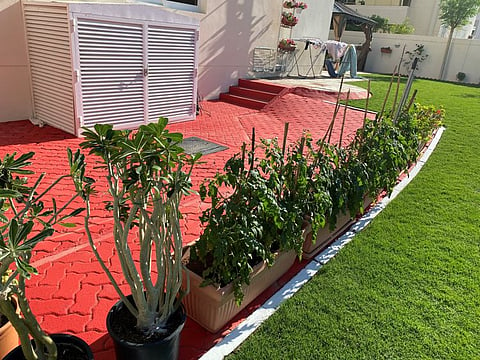Want to protect your kitchen garden from rough weather? Follow these simple tips from UAE horticulturists
From repotting, to aerating and replenishing nutrients, here’s how you can save plants

Dubai: While UAE residents were overjoyed with the recent bout of heavy seasonal showers, the heavy moisture, dampness, lack of sunlight and dust from gusty winds damaged the little patches of green so painstakingly developed by people around their homes.
However, every drop of rain is worth it and UAE residents can work towards restoring the health of their gardens despite inclement weather.
Salvaging flowering plants from heavy rains
Kumari Shenoy, a hobby horticulturist, has been in Dubai for more than 53 years and her garden is talk of the town. As a member of the Dubai Gardening Club, she shared her knowledge of plant conservation with Gulf News.
“I welcomed the rain this week as it was such an unusual weather and enjoyed the dip in the mercury. Last week, trees such as Moringa, Frangipani, Bougainvillea, fruit trees and flowers such as Miltonia thrived well in the showers. However, I was worried about my potted plants. Most plants in this region are meant to grow in arid soil. Plants of the succulent family, such as the cacti, suffer a lot due to water-logging. Those in pots can be salvaged while there is not much one can do about bigger trees and shrubs planted in the soil,” elaborated Shenoy.
Re-pot your plants
“For flowering and seasonal winter plants in pots, especially the succulent ones, one can take a few quick steps for salvaging them, in case there is heavy shower and gusty wind.
"First, in order to protect potted plants, move them into the garage or a covered area for a short period until the weather improves. If that is not possible, once the cloud-cover clears, you can repot these plants. I have started repotting my plants. For this, I shake out all the damp soil and aerate it well. This dries out the excessive moisture in it and then I use only 50 per cent of this soil. Mix these two together to get a good balance. I use the locally available potting soil, add peat moss, vermi-compost and bone meal to fortify it. The peat moss helps to drain out the water as most plants in this region thrive well in arid soil. The vermi-compost and bone meal (crushed animal bone powder) fortify the soil with nutrients, organic minerals and probiotics. I am replanting all my potted plants in this to minimise the damage caused by the weather.”
Supporting the slender runners
Indian expatriate Ibrahim Gadivala is a keen kitchen gardener as well as a commercial farmer with a hydroponic farm in Ras Al Khaimah. He explained how plants age prematurely with rough weather. “In the previous week, a lack of strong sunlight, very cold weather, heavy rain, accompanied with strong winds and excessive dust, damaged the health of my plants, especially the musk melons and the winter flowers. They looked aged. To minimise this damage, I have taken a few steps.”
Gadivala suggested that in the kitchen garden, it is advisable to provide extra support to the creepers such as cucumber and tomatoes. “In case of tomatoes, if you frequently trim the creeper and clear the supporting runners and provide good support to the central stem with extra-strong bamboo props, it will help the runner grow well. The central stem can grow up to a height of six feet when trimmed in this way.”
Drain out excessive moisture
Gadivala further suggested draining out water from flowering plants such as petunias and keeping them sheltered from heavy rains with a screen or cover.
“These plants require very little water. Adding compost and bone meal to the soil is a good step to replenish the soil that may have its nutrients washed away by water. However, it is important not to add too much of this as bone meal,” he cautioned. That is because horticulturists have pointed out that bone meal is rich in phosphorous and excessive bone meal can result in yellow leaves. Besides, it takes a long time of at least four months for a full breakdown of the nutrients. Excessive bone meal can make the soil too alkaline and block nutrient uptake.
However, both the gardening enthusiasts pointed out that with some vigilance and care, the adverse effects of rough weather can be completely neutralised.
Top tips to salvage your green patch after heavy rains:
• To prevent damage, try to construct a shelter or screen to prevent flowering plants from being in the firing line of strong winds and heavy rains. If possible, move them to a garage or store temporarily.
• Repot your plants after heavy rain to prevent water-logging and premature ageing.
• Take out the soil, aerate it well, drain out the excessive moisture, add fresh soil, peat moss vermi-compost, bone meal and repot plants in the spoil.
• Provide sturdy external support to runners such as beans, tomatoes, cucumbers to withstand the strong gusty winds.
• Drain out the water from flowering plants.
Sign up for the Daily Briefing
Get the latest news and updates straight to your inbox


